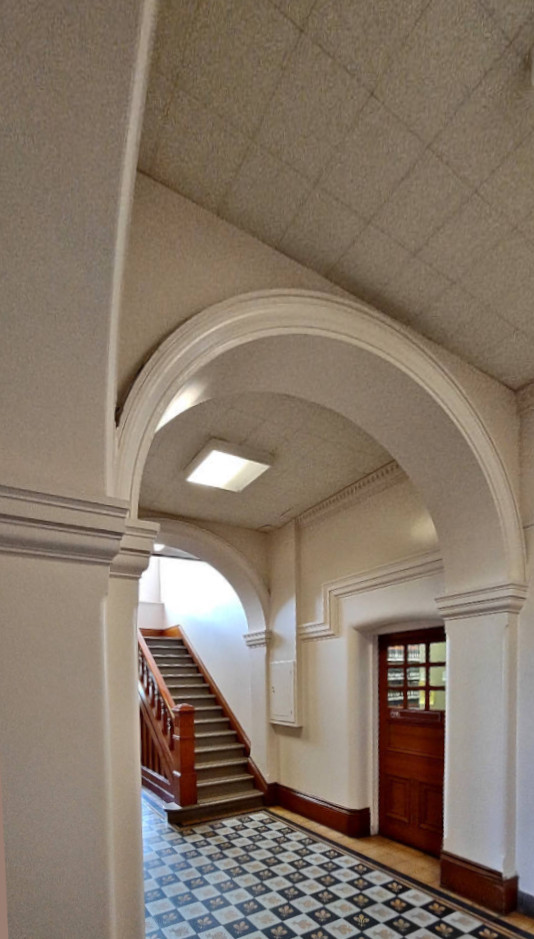Photographs by the author. [You may use these images without prior permission for any scholarly or educational purpose as long as you (1) credit the person who scanned the image and (2) link your document to this URL in a web document or cite the Victorian Web in a print one. Click on all the images to enlarge them.]

The Court House, Nanaimo, B. C. 1895. Designed by English immigrant architect Francis Mawson Rattenbury, the Court House dominated the late-Victorian city of Nanaimo, which became the province's second most populous city as a result of the discovery of coal seams there, and the construction of the Esquimalt and Northern Railway. The building is located at 31 — 35 Front Street. Its grand arched Romanesque front immediately calls to mind Rattenbury's ambitious design for the Parliament Buildings in Victoria, B. C., but also incorporates elements of the Richardsonian Romanesque (the style inspired by the American architect, Henry Hobson Richardson, seen for example his Lululaund in England). Such elements include semi-circular, banded windows and rusticated masonry. This was a fashionable style in British Columbia at this time, witness Craigdorrach Castle (1889) in Victoria.
The Court House is succinctly introduced in the Nanaimo Heritage Register: "Grand and imposing in its rugged monumentality, this structure serves as the symbol of justice in Nanaimo. Around the turn of the century, the rapidly expanding population had necessitated a reorganization of the provincial court system, and a number of new regional court houses were constructed. . . . Replacing an earlier wooden Court House, this expensive and sophisticated building projected provincial authority and power and, at the same time, signaled Nanaimo’s nascent function as a regional centre.



Closer views of the Romanesque façade and portico.
The exterior also reminds us of Rattenbury's own Bank of Montreal at Bastion Square, Victoria, with its rough-dressed masonry and prominent round arched openings. The roofline is slate covered, but features an intricate copper ornamentation. Rattenbury was now at the height of his powers, designing the Vancouver and Nelson Court Houses, too, not to mention the Empress Hotel, and numerous other residential and institutional buildings. This building, and the Nelson Court House, represent a continuation of his interest in what the Heritage Register calls "the picturesque eclecticism of the Late Victorian era."


Two views of an interior passage and staircase, with late nineteenth-century tile-work.
Barrett and Liscombe note that the Nanaimo building represents a simplified version of the central portal of the Victoria Legislative Buildings "with Chateau-style pitched roofs on the corner towers" (294). Rattenbury's bold mix of architectural elements was influential elsewhere in British Columbia. Architects J. J. Honeymoon and G. D. Curtis, for instance, essentially copied this building and the Vancouver Court House respectively at Rossland and at Revelstoke.
Facing a major street in the core of old Nanaimo, the building's height and substantial mass make it a prominent landmark in the modern downtown. "To increase the formality of the design and the presence of the building, the building is set to the rear of the sloping site. This position allowed for a gracious landscaped plaza at the front" (Heritage Register).
Photographs and commentary by Philip V. Allingham. [You may use these image without prior permission for any scholarly or educational purpose as long as you (1) credit the photographer and (2) link your document to this URL in a web document or cite the Victorian Web in a print one.]
Bibliography
Barrett, Anthony A., and Rhodri Windsor Liscombe. Francis Rattenbury and British Columbia: Architecture and Challenge in the Imperial Age. Vancouver: University of British Columbia Press, 1983.
Elliot, David R. "Rattenbury, Francis Mawson." Canadian Encyclopedia. Edmonton: Hurtig, 1988. Vol. 3: 1828-1829.
Heritage Register (City of Nanaimo). "Nanaimo Courthouse, Front Street (1895)." Web. Accessed 3 May 2023.
Liscombe, Rhodri Windsor. "Rattenbury, Francis Mawson." The Canadian Encyclopedia. Posted 20 May 2008. Web. Accessed 25 April 2023.
Created 8 May 2017